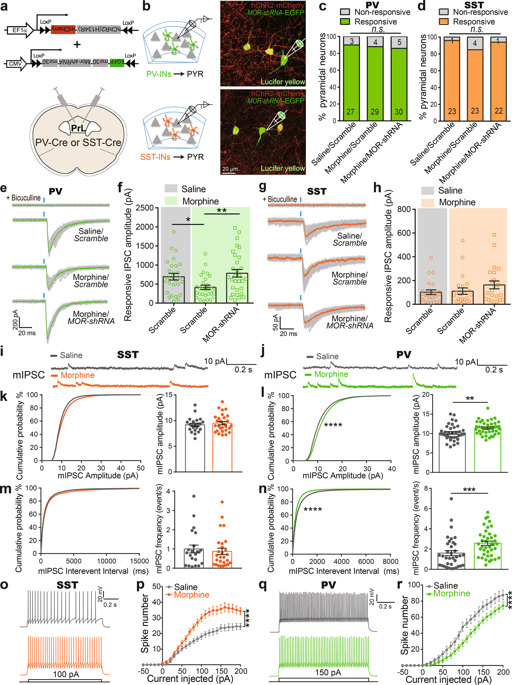Molecular Psychiatry ( IF 9.6 ) Pub Date : 2019-08-14 , DOI: 10.1038/s41380-019-0480-7 Changyou Jiang 1 , Xueying Wang 1 , Qiumin Le 1 , Peipei Liu 1 , Cao Liu 1 , Zhilin Wang 1 , Guanhong He 1 , Ping Zheng 1 , Feifei Wang 1 , Lan Ma 1

|
Opioids, such as morphine, are clinic analgesics which induce euphoria. Morphine exposure modifies the excitability and functional interactions between neurons, while the underlying cellular and molecular mechanisms, especially how morphine assembles heterogeneous interneurons (INs) in prelimbic cortex (PrL) to mediate disinhibition and reward, are not clear. Using approaches of optogenetics, electrophysiology, and cell type-specific RNA-seq, we show that morphine attenuates the inhibitory synaptic transmission from parvalbumin+ (PV)-INs onto pyramidal neurons in PrL via μ-opioid receptor (MOR) in PV-INs. Meanwhile, morphine enhances the inhibitory inputs from somatostatin+ (SST)-INs onto PV-INs, and thus disinhibits pyramidal neurons via δ-opioid receptor (DOR)-dependent Rac1 upregulation in SST-INs. We show that MOR in PV-INs is required for morphine-induced behavioral sensitization, while DOR as well as Rac1 activity in SST-INs is required for morphine-induced conditioned place preference and hyper-locomotion. These results reveal that SST- and PV-INs, functioning in PrL as a disinhibitory architecture, are coordinated by morphine via different opioid receptors to disinhibit pyramidal neurons and enhance reward.
中文翻译:

吗啡可协调前肢皮层中的SST和PV中间神经元,以抑制锥体神经元并增强奖赏。
阿片类药物(例如吗啡)是引起欣快感的临床止痛药。吗啡暴露会改变神经元之间的兴奋性和功能相互作用,而潜在的细胞和分子机制,尤其是吗啡如何在前缘皮层(PrL)中组装异质中间神经元(IN)来介导去抑制和奖励,尚不清楚。使用光遗传学,电生理学和细胞类型特定的RNA序列的方法,我们表明吗啡通过PV-INs中的μ阿片受体(MOR)减弱了小白蛋白+(PV)-INs抑制性突触传递到PrL的锥体神经元中。 。同时,吗啡可增强生长抑素+的抑制性输入(SST)-INs到PV-INs上,因此通过SST-INs中的δ阿片受体(DOR)依赖性Rac1上调来抑制锥体神经元。我们表明吗啡诱导的行为敏化需要PV-INs中的MOR,而吗啡诱导的条件性位置偏爱和运动过度则需要DOR以及SST-INs中的Rac1活性。这些结果表明,在PrL中起抑制作用的SST-和PV-INs与吗啡通过不同的阿片样物质受体协同作用,以抑制锥体神经元并增强奖赏。















































 京公网安备 11010802027423号
京公网安备 11010802027423号